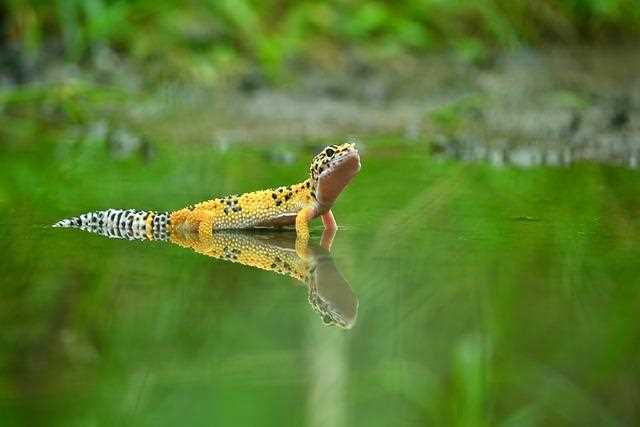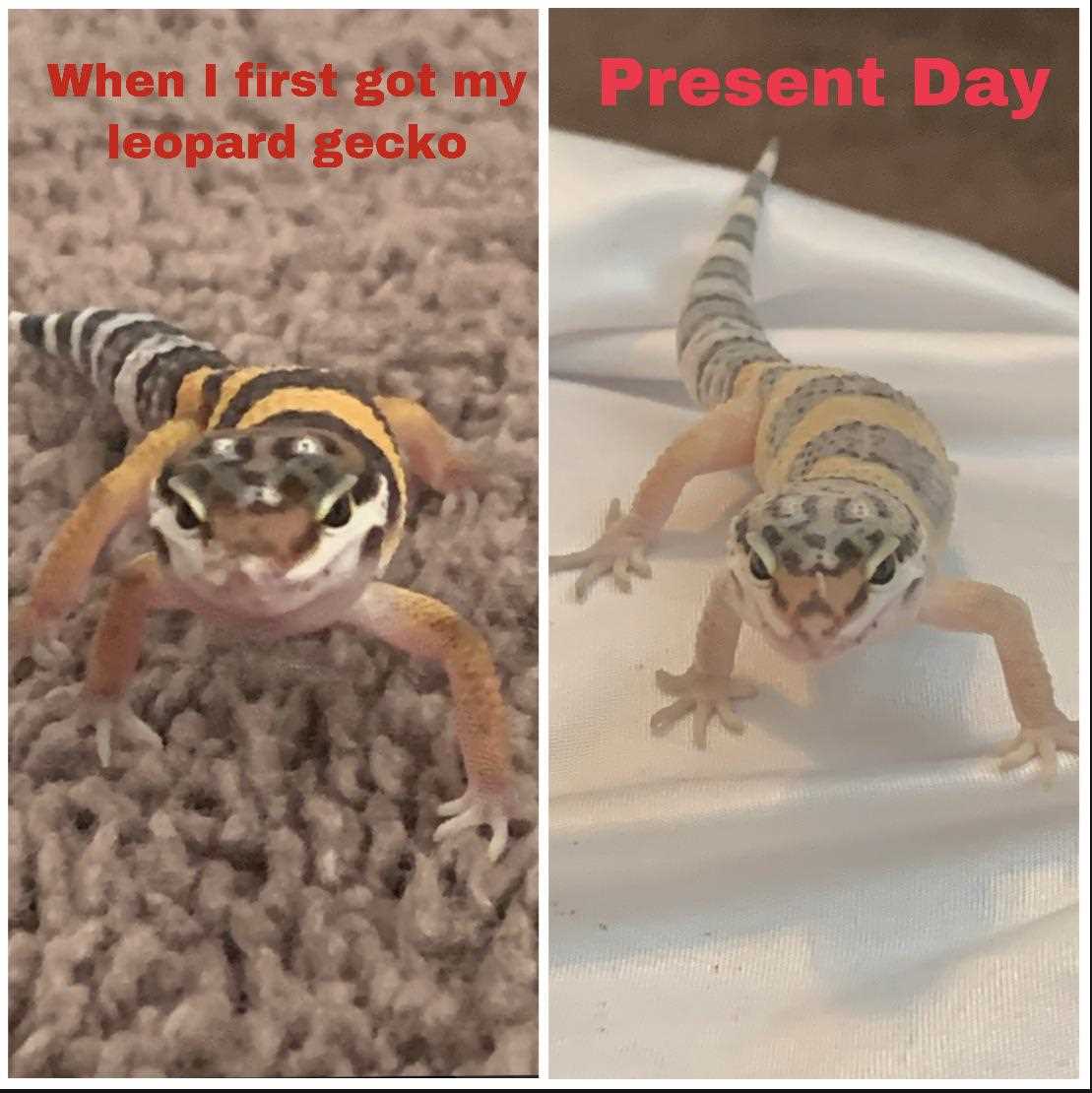There are several possible reasons for a leopard gecko to turn white. One reason could be a genetic mutation that affects the production of skin pigments. This genetic variation can cause the gecko to lose its original colors and become white. Another possibility is that the white coloration is a result of the gecko shedding its old skin. During the shedding process, the gecko’s skin may appear white before the new skin underneath has a chance to fully develop its usual coloration.
My leopard gecko, for instance, went through a period of turning white during each shedding cycle. It was always a fascinating sight to see her transform from her usual vibrant colors to a completely white appearance. However, after a few days, her new skin would start to show its true colors, and she would once again be a beautiful mix of oranges and yellows.
The Natural Habitat of Leopard Gecko and Why it is Turning White?
Natural Habitat:
Leopard geckos are primarily found in the arid and rocky regions of their native habitat. They are nocturnal creatures, preferring to hide in cool and dark crevices during the day and emerging at night to hunt for food. These geckos have evolved to adapt to the harsh desert environment, and their coloration plays a vital role in their survival.
In their natural habitat, leopard geckos have a distinct mix of colors and patterns that help them blend in with their surroundings. Their skin usually features shades of yellow, brown, and gray, which serve as excellent camouflage against the sandy desert backdrop. This natural coloration helps them remain hidden from both predators and prey.
Why are Leopard Geckos Turning White?
While the natural coloration of leopard geckos is primarily yellow, brown, and gray, it is not uncommon for these reptiles to exhibit color changes, including turning white. There are several reasons why a leopard gecko might turn white, and it is essential to understand these factors to ensure their overall well-being.
- Age-related color changes: As leopard geckos age, they might experience natural color changes. Some older geckos may develop patches of white or lighter-colored scales, which is a common occurrence and not a cause for concern.
- Genetic factors: Certain genetic factors can influence the coloration of leopard geckos. Breeders have selectively bred geckos to produce specific color variations, including white leopard geckos. However, it is worth noting that not all white leopard geckos are genetically modified, as some individuals may naturally exhibit this coloration.
- Environmental factors: The environment in which a leopard gecko is kept can also affect its coloration. Insufficient exposure to UVB light, inadequate temperature regulation, or improper humidity levels can cause stress and impact their natural coloration. Providing a suitable and well-maintained habitat for your gecko is crucial to prevent color changes.
- Nutritional deficiencies: Leopard geckos require a balanced diet to maintain their health and vibrant coloration. Nutritional deficiencies, particularly in vitamins and minerals, can lead to pale or white scales. Ensuring your gecko receives a varied diet and appropriate supplementation is vital.
- Stress: Stress can manifest in various ways in leopard geckos, including changes in coloration. Factors such as handling, overcrowded enclosures, or aggressive tank mates can induce stress and result in a gecko turning white. Minimizing stressors and creating a calm and secure environment is essential for their well-being.
- Health issues: Certain health conditions can cause a leopard gecko to turn white. These conditions include infections, parasites, or underlying systemic diseases. If your gecko’s color change is accompanied by other signs of illness, it is crucial to seek veterinary attention promptly.
- Breeding and selective breeding: Breeders have been successful in selectively breeding leopard geckos to exhibit specific color variations, including solid white individuals. The breeding process involves pairing geckos with desired traits to produce offspring with a higher likelihood of showcasing those traits.
Normal Coloration of Leopard Gecko
A leopard gecko is known for its unique and beautiful coloration. Typically, the gecko’s skin has a base color that ranges from yellow to brown, with spots or bands of darker colors such as black, brown, or dark orange. The pattern and intensity of these colors can vary among individuals, resulting in a wide array of beautifully patterned leopard geckos.
One of the distinguishing features of a healthy leopard gecko is its vibrant and consistent coloration. The colors should be evenly distributed across the body, and any significant changes in color may indicate an underlying health issue or environmental factor.
Leopard geckos can exhibit various color morphs, which are genetic variations that result in different color patterns. These morphs can be inherited and selectively bred to produce geckos with specific colorations. Popular morphs include albino, snow, and tangerine, among others.
Factors Influencing Coloration
The coloration of a leopard gecko can be influenced by both genetic and environmental factors. Genetic factors play a significant role in determining the base color and pattern of the gecko. Different color morphs have specific genetic traits that contribute to their unique coloration. For example, albino geckos lack melanin pigment, resulting in a white or pale coloration.
Environmental factors can also affect the coloration of a leopard gecko. For example, temperature plays a crucial role in determining the intensity of the gecko’s coloration. Cooler temperatures may result in a darker and more vibrant color, while warmer temperatures can cause the colors to fade or become lighter.
In addition to genetic and environmental factors, the gecko’s diet can also impact its coloration. A proper and balanced diet rich in essential nutrients, such as vitamins and minerals, is crucial for maintaining the gecko’s color. Nutritional deficiencies can lead to faded or dull coloration.
Signs of Abnormal Color Change
My Leopard Gecko is Turning White: Why It Happens and What It Means

Genetic factors also play a role in leopard gecko coloration. Breeders have selectively bred geckos to produce specific color morphs, including those with white or light-colored skin. These genetic variations can result in geckos that naturally exhibit white coloration. Therefore, if a gecko is born with white skin, it may simply be a result of its genetic makeup.
Environmental factors can also influence the color change in leopard geckos. Exposure to extreme temperatures, such as intense heat or cold, can cause stress and lead to temporary color changes. Additionally, changes in lighting, humidity levels, or habitat conditions can affect the gecko’s skin pigmentation.
Stress is another factor that can impact the coloration of leopard geckos. These reptiles can experience stress due to various reasons, including improper handling, sudden changes in their environment, or the presence of predators or other geckos. When stressed, a gecko may turn pale or white, indicating its discomfort.
Lastly, health issues can cause white coloration in leopard geckos. Skin infections, parasites, or other medical conditions can affect the gecko’s skin pigmentation and overall appearance. It is crucial to monitor the gecko’s health and seek veterinary care if any concerning symptoms, including white skin, persist.
Why is the Leopard Gecko Turning White?
The Leopard Gecko is known for its vibrant and beautiful coloration, with shades of yellow, orange, and brown. However, it is not uncommon for Leopard Geckos to experience a change in coloration and turn white. This phenomenon can be attributed to various factors, including genetic and environmental influences.
Genetic Factors Affecting Coloration
One of the primary reasons for the Leopard Gecko turning white is the presence of certain genetic factors. These factors can affect the melanin production in the gecko’s skin, which is responsible for its pigmentation. Genetic mutations can result in a reduction or absence of melanin production, causing the gecko’s skin to appear white or pale.
Environmental Factors Influencing Color Change

Apart from genetic factors, the color change of the Leopard Gecko to white can also be influenced by the environment in which it lives. Temperature and lighting conditions play a crucial role in the gecko’s pigmentation. Inadequate temperature regulation or improper lighting can inhibit the synthesis of melanin, leading to a change in coloration.
Furthermore, the intensity and duration of exposure to ultraviolet (UV) light can impact the gecko’s pigmentation. UV light is essential for the synthesis of vitamin D3, which is required for calcium metabolism. Insufficient UV exposure can result in nutritional deficiencies and affect the gecko’s overall health, potentially causing changes in skin color.
Additionally, stressors in the gecko’s environment, such as overcrowding or improper handling, can also contribute to color change. High-stress levels can disrupt the gecko’s natural physiological processes and trigger abnormal coloration, including turning white.
Conclusion
Why is my leopard gecko turning white?
Leopard geckos, like other reptiles, have the ability to change their skin color for various reasons. While they are typically known for their beautiful patterns and vibrant colors, it is not uncommon for leopard geckos to exhibit a white coloration. This change in color can occur for several reasons, including environmental factors.
Environmental Factors Influencing Color Change
One of the main reasons why a leopard gecko may turn white is due to environmental factors. These factors can include temperature, lighting, and humidity levels. Leopard geckos are ectothermic creatures, meaning they rely on external sources to regulate their body temperature. If the temperature in their enclosure is too cold, it can cause their skin to turn white as a response to the temperature stress. Similarly, if the lighting or humidity levels are not suitable for the gecko, it can also lead to changes in coloration.
In some cases, a leopard gecko may turn white as a form of camouflage. In the wild, these reptiles use their coloration to blend into their surroundings and remain undetected by predators. If a leopard gecko feels threatened or stressed in its environment, it may adopt a defensive strategy by turning white to blend in with its surroundings and avoid detection.
Another environmental factor that can influence color change in leopard geckos is the presence of other geckos. When kept in the same enclosure with another gecko, especially during breeding season, a leopard gecko may exhibit a temporary white coloration as a way to establish dominance or attract a mate.
Why Is My Leopard Gecko Turning White?
Proper nutrition is crucial for maintaining the health and appearance of a leopard gecko. Inadequate diet or improper supplementation can lead to deficiencies in essential nutrients, such as calcium, vitamin D3, and beta-carotene. These deficiencies can affect the pigmentation and result in a change of color, including turning white.
Another possible cause of white coloration in leopard geckos is stress. Geckos can become stressed due to various factors, such as improper handling, overcrowding, changes in the environment, or conflicts with other geckos. When stressed, leopard geckos may experience a temporary color change, including turning white. Ensuring a stress-free and suitable habitat, proper handling techniques, and minimizing disturbances can help prevent stress-related color changes.
It is also important to consider the overall health of the leopard gecko. Certain health issues, such as skin infections, parasites, or underlying diseases, can manifest as changes in coloration. If your gecko’s color change is accompanied by other signs of illness, such as lethargy, loss of appetite, or abnormal behavior, it is essential to seek veterinary care for proper diagnosis and treatment.
Conclusion
Why is my leopard gecko turning white?
1. Stress
2. Health issues
Another possible reason for a leopard gecko turning white is health issues. Certain diseases or medical conditions can affect the pigmentation of the gecko, leading to a loss of color. Some health issues that may cause color change include metabolic bone disease, infections, and parasites. If you notice your gecko turning white, it is essential to consult a veterinarian to rule out any underlying health problems.
3. Environmental factors
Environmental factors can also influence the color change of a leopard gecko. Temperature fluctuations, improper lighting, and inadequate humidity levels can all impact the gecko’s coloration. It is crucial to provide the gecko with a suitable and stable environment to ensure its overall health and maintain its normal coloration.
4. Age-related color changes
5. Genetic factors

Genetics can also play a role in the coloration of leopard geckos. Some geckos may have genetic variations that cause them to be white or have a lighter coloration. These genetic factors can be passed down through breeding, resulting in the production of white leopard geckos.
Health issues and white coloration in leopard gecko
One of the important factors that can cause a leopard gecko to turn white is health issues. It is essential for owners to understand that white coloration in a leopard gecko may be a sign of an underlying health problem that needs to be addressed.
There are several health issues that can contribute to the change in color of a leopard gecko. One common cause is stress, which can cause the gecko’s color to fade or turn white. Stress can be due to various factors such as improper handling, inappropriate temperature or humidity levels, or even the presence of predators in the environment.
Another possible cause of white coloration in a leopard gecko is a nutritional deficiency. If the gecko is not getting the proper nutrients it needs, it may start to lose color or turn white. This can be caused by a diet that is lacking in essential vitamins, minerals, or other nutrients.
Furthermore, certain diseases or infections can also lead to white coloration in leopard geckos. For example, skin infections or parasites can cause the gecko’s skin to appear white due to the inflammation and damage they cause. Additionally, diseases that affect the gecko’s organs or immune system can also result in color changes.
It is crucial for leopard gecko owners to monitor their pet’s health closely and seek veterinary attention if they notice any unusual changes in color. A veterinarian can perform tests and examinations to determine the underlying cause of the white coloration and provide appropriate treatment.
Breeding and Selective Breeding for White Leopard Geckos
One of the most intriguing aspects of leopard geckos is their ability to exhibit a range of color variations, including the highly sought-after white leopard geckos. The process of breeding and selective breeding has played a significant role in achieving this unique and captivating coloration.
The breeding process involves carefully selecting the parent geckos based on their color genetics. For example, geckos that possess the “Mack Snow” or “Tremper Albino” genes are more likely to produce white offspring. These genes are responsible for reducing melanin production, resulting in a lighter coloration. By breeding geckos with these genes over several generations, breeders can increase the prevalence and intensity of white coloration in their offspring.
Selective breeding requires careful record-keeping and tracking of genetic lines. Breeders need to keep track of which geckos possess the genes for white coloration and which combinations of genes are likely to produce white offspring. This information helps them make informed decisions when pairing geckos for breeding, increasing the likelihood of producing white leopard geckos.
Furthermore, the success of breeding for white leopard geckos relies on the careful selection of healthy and genetically sound parent geckos. Geckos with underlying health issues or genetic defects are less likely to produce offspring with desirable colorations. Therefore, it is crucial for breeders to ensure the overall health and wellbeing of their breeding geckos to increase the chances of producing healthy white leopard geckos.

I’m Lena Adams—a product of an unconventional upbringing in the African wilderness. My father, a daring explorer of African wildlife, sparked my fascination with reptiles, a passion that intertwined with the tragic loss of my mother during an expedition, leaving an indelible mark on my life. Driven to understand the creatures that captivated my parents, I embarked on my journey, sharing insights about reptiles, frogs, and lizards on my website. Through my explorations and conservation efforts, I honour my family’s legacy while seeking connections—to the creatures, nature, and the mother whose presence I yearn to understand.
